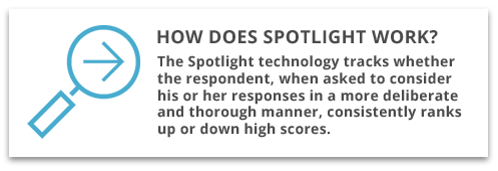How do you prevent faking in personality testing?
The use of tests has become an important method for selection and recruitment and the use of personality tests is growing. A body of evidence (Judge et al. 2002, Judge et al. 2013, Barrick et al. 2001) shows that personality tests are predictive of job performance, and they are widely used to screen in potential candidates and to assess and evaluate person-job fit throughout the recruitment process.
The aim for any personality test is to accurately describe behavioral characteristics. Since the assessment of personality is based on self-reporting, concerns about the possibility that some respondents systematically attempt to present a socially desirable conforming or false picture of their personality has been an ongoing discussion in the literature of personality testing. This concern has raised a need for control to minimize the risk of faking a test result, in particular for normative constructed personality tests. When steps are taken to control faking, self-reporting assessments have proven to be a benefit for both the candidate and the organization in hiring processes.
Dealing with concerns about faking
The construction and format of the personality test OPTO has an in-built technology (Spotlight) to deal with concerns about high response quality, high face validity and preventing faking.
The Spotlight technology is based on the knowledge from cognitive psychology and the theory about decision making, which suggest that the process of responding to a questionnaire will be qualitatively better if the respondent is forced into a more cognitively demanding answering process (effortful thinking), rather than answering with a more immediate answer strategy (intuitive thinking). Theories of psychology and decision making describe how decisions are susceptible to perspective effects, meaning when the same item in a questionnaire is framed differently (presented with a different answering format) it may lead the respondent to reconsider the original response. This is caused by a change in the relative attractiveness of a given answering option, when the same item is presented in different ways (Kahneman 2013). Forcing the respondents to more in-depth considerations about the answers they give to the items in the OPTO questionnaire, gives a more varied answering style due to the increased cognitive focus on the nuances between the items.
The Spotlight technology presents the items in a forced choice format, which is commonly accepted to minimize and even prevent faking, since the respondent is asked to prioritise. In addition, Spotlight provides secondary information on areas where a candidate may be less clear about his/her preference and highlight points for further exploration related to person-job fit. The psychometric documentation of OPTO shows that Spotlight strengthens the quality of the questionnaire.


In conclusion, careful considerations about tools/methods applied to support a given recruitment strategy not only allows for efficient talent acquisition processes with high business impact, but also ensures that job applicants are left with a positive experience, whether they got the job or not.





